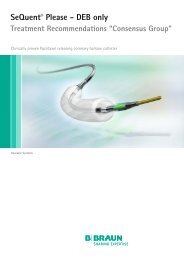PACCOCATH ISR I/II - Deb-bbraun.de
PACCOCATH ISR I/II - Deb-bbraun.de
PACCOCATH ISR I/II - Deb-bbraun.de
Create successful ePaper yourself
Turn your PDF publications into a flip-book with our unique Google optimized e-Paper software.
TCT 2007 - Late Breaking Studies and First Report Investigations<br />
Wednesday, October 24 2007, Main area<br />
<strong>PACCOCATH</strong> <strong>ISR</strong> 1 and 2:<br />
A Prospective, Randomized Trial of a<br />
Paclitaxel-Eluting Balloon in In-Stent<br />
Restenosis: 2-Year Results<br />
Bruno Scheller<br />
for the Paccocath <strong>ISR</strong> Study Group<br />
Klinik für Innere Medizin <strong>II</strong>I, Universitätsklinikum <strong>de</strong>s<br />
Saarlan<strong>de</strong>s, Homburg / Saar, Germany
Presenter Disclosure Information<br />
Bruno Scheller, MD<br />
The following relationship exists related to this<br />
presentation:<br />
Coinventor of a patent application for various methods of restenosis<br />
inhibition, including the technique employed in this trial, by Charité<br />
University Hospital, Berlin<br />
<strong>PACCOCATH</strong> in patients is investigational only
Presenter Disclosure Information<br />
Bruno Scheller, MD<br />
The following relationship exists related to this<br />
presentation:<br />
Coinventor of a patent application for various methods of restenosis<br />
inhibition, including the technique employed in this trial, by Charité<br />
University Hospital, Berlin<br />
UNLABELED/UNAPPROVED USES DISCLOSURE:<br />
<strong>PACCOCATH</strong> in patients is investigational only
Drug-Eluting Balloon (<strong>PACCOCATH</strong>)<br />
Drug-Eluting Stent<br />
• Slow release<br />
• Persistent drug exposure<br />
• ~ 100 - 200 µg dose<br />
• Polymer<br />
• Stent mandatory<br />
Drug-Eluting Balloon<br />
(<strong>PACCOCATH</strong>)<br />
• Immediate release<br />
• Short-lasting exposure<br />
• ~ 300 - 600 µg dose<br />
• No polymers<br />
• Premounted stent optional<br />
Circulation 2004; 110: 810-4, Heart 2007, 93: 539-41
Primary endpoint (late lumen loss in-segment)<br />
Uncoated balloon<br />
<strong>PACCOCATH</strong><br />
0.74 ± 0.86 mm 0.03 ± 0.48 mm<br />
New Engl J Med 2006, 355: 2113-24
<strong>PACCOCATH</strong> <strong>ISR</strong> I<br />
New Engl J Med 2006, 355: 2113-24
<strong>PACCOCATH</strong> <strong>ISR</strong> I/<strong>II</strong><br />
Efficacy and Safety of Paclitaxel-Coated Balloons<br />
in Coronary In-Stent Restenosis<br />
Homburg/Saar, Freiburg, Charité Mitte Berlin,<br />
Charité Virchow Berlin, Mannheim-Hei<strong>de</strong>lberg<br />
• Two trials<br />
–separately randomized<br />
–double-blind, multicenter<br />
–i<strong>de</strong>ntical protocol<br />
–108 patients in total<br />
• Paccocath <strong>ISR</strong> I<br />
–52 patients<br />
• Paccocath <strong>ISR</strong> <strong>II</strong><br />
–56 patients
<strong>PACCOCATH</strong> <strong>ISR</strong> I/<strong>II</strong><br />
• Main inclusion criteria<br />
– Clinically relevant coronary <strong>ISR</strong><br />
– Diameter stenosis > 70 %<br />
– Lesion length < 30 mm<br />
– Vessel diameter 2.5 to 3.5 mm<br />
• Repeated PTCA of coronary<br />
<strong>ISR</strong><br />
– Coated balloon with 3 µg<br />
paclitaxel / mm² balloon<br />
surface and iopromi<strong>de</strong><br />
(Ultravist ® )<br />
– Uncoated balloon of the same<br />
type (BMT, Oberpfaffenhofen)<br />
• Primary endpoint<br />
– In-segment late lumen loss after 6<br />
months<br />
– In<strong>de</strong>pen<strong>de</strong>nt, blin<strong>de</strong>d<br />
angiographic core lab<br />
• U. Dietz, Wiesba<strong>de</strong>n<br />
• Secondary endpoints<br />
– Binary restenosis rate, MACE<br />
• Statistics<br />
– p-values adjusted according to<br />
Fisher’s method of combining<br />
in<strong>de</strong>pen<strong>de</strong>nt tests<br />
• ASA + clopidogrel<br />
– 4 weeks in both groups
<strong>PACCOCATH</strong> <strong>ISR</strong> I/<strong>II</strong> – Patient Characteristics<br />
Uncoated balloon<br />
n 54<br />
Drug-coated balloon<br />
Age 66.3 ± 9.8 years 65.4 ± 10.3 years 0.805<br />
Male gen<strong>de</strong>r 31 (57 %) 42 (77 %) 0.125<br />
54<br />
p<br />
Diabetes mellitus<br />
Insulin-<strong>de</strong>pen<strong>de</strong>nt<br />
11 (20 %)<br />
6 (11%)<br />
9 (17 %)<br />
3 (6 %)<br />
0.313<br />
Hyperlipi<strong>de</strong>ma 72 % 78 %<br />
0.485<br />
Smoking 48 % 43 %<br />
0.772<br />
Hypertension 82 % 82 %<br />
0.866<br />
Unstable angina 41 % 37 %<br />
1.000<br />
Single-vessel<br />
disease<br />
Two-vessel disease<br />
Three-vessel disease<br />
13 (24 %)<br />
19 (35 %)<br />
22 (41 %)<br />
9 (17 %)<br />
24 (44 %)<br />
21 (39 %)<br />
0.495<br />
RCA<br />
CX<br />
LAD<br />
17 (32 %)<br />
12 (22 %)<br />
25 (46 %)<br />
18 (33 %)<br />
13 (24 %)<br />
23 (43 %)<br />
0.611<br />
p-values adjusted according to Fisher’s method of combining in<strong>de</strong>pen<strong>de</strong>nt tests
<strong>PACCOCATH</strong> <strong>ISR</strong> I/<strong>II</strong> - Lesions<br />
60%<br />
50%<br />
Patterns of <strong>ISR</strong> (Mehran classification) <strong>ISR</strong> I/<strong>II</strong> (n=108)<br />
p=0.38<br />
Uncoated balloon<br />
Drug-coated balloon<br />
40%<br />
30%<br />
20%<br />
10%<br />
0%<br />
IA IB IC ID <strong>II</strong> <strong>II</strong>I IV<br />
p-values adjusted according to Fisher’s method of combining in<strong>de</strong>pen<strong>de</strong>nt tests
<strong>PACCOCATH</strong> <strong>ISR</strong> I/<strong>II</strong> - Intervention<br />
Uncoated balloon<br />
n 54<br />
Drug-coated balloon<br />
54<br />
p<br />
Study balloon<br />
Diameter<br />
Length<br />
3.0 ± 0.3 mm<br />
24.3 ± 5.0 mm<br />
3.0 ± 0.3 mm<br />
24.1 ± 4.9 mm<br />
1.000<br />
0.592<br />
Mean pressure 12.7 ± 2.7 atm 12.5 ± 2.6 atm 0.819<br />
Balloon inflation time 68.9 ± 37.7 sec 77.2 ± 42.2 sec 0.063<br />
Paclitaxel residue on<br />
balloon post-angioplasty<br />
-<br />
4.2 ± 4.1% (<strong>ISR</strong> I)<br />
Restenotic DES 2 (4 %) 2 (4 %)<br />
1.000<br />
Additional stents 2 (4 %) 3 (6 %)<br />
1.000<br />
GP <strong>II</strong>b/<strong>II</strong>Ia antagonists 7 (13 %) 5 (9 %)<br />
1.000<br />
p-values adjusted according to Fisher’s method of combining in<strong>de</strong>pen<strong>de</strong>nt tests
<strong>PACCOCATH</strong> <strong>ISR</strong> I/<strong>II</strong><br />
Angiographic measurements at treatment<br />
Uncoated balloon Drug-coated balloon p<br />
n 54 54<br />
Left ventricular function 60.3 ± 13.9 % 60.8 ± 14.5 % 0.862<br />
Lesion length<br />
18.6 ± 8.3 mm<br />
18.3 ± 9.7 mm<br />
0.845<br />
Reference diameter<br />
2.94 ± 0.37 mm<br />
2.94 ± 0.35 mm<br />
0.731<br />
Minimal lumen diameter initial<br />
0.70 ± 0.35 mm<br />
0.63 ± 0.29 mm<br />
0.015<br />
Minimal lumen diameter post<br />
angioplasty<br />
2.34 ± 0.44 mm<br />
2.43 ± 0.47 mm<br />
0.955<br />
p-values adjusted according to Fisher’s method of combining in<strong>de</strong>pen<strong>de</strong>nt tests
<strong>PACCOCATH</strong> <strong>ISR</strong> I/<strong>II</strong><br />
Angiographic measurements at follow-up angiography<br />
Uncoated balloon Drug-coated balloon p<br />
n 54 54<br />
Follow-up angiography<br />
49 (91 %)<br />
47 (87 %)<br />
0.944<br />
Minimal lumen diameter<br />
In-stent<br />
In-segment<br />
1.53 ± 0.81 mm<br />
1.50 ± 0.79 mm<br />
2.30 ± 0.62 mm<br />
2.23 ± 0.57 mm<br />
0.003<br />
0.004<br />
Late lumen loss<br />
In-stent<br />
In-segment<br />
0.81 ± 0.79 mm<br />
0.80 ± 0.79 mm<br />
0.14 ± 0.46 mm<br />
0.11 ± 0.44 mm<br />
0.001<br />
0.001<br />
Binary restenosis rate<br />
In-stent<br />
In-segment<br />
24 (49 %)<br />
25 (51 %)<br />
3 (6 %)<br />
3 (6 %)<br />
0.001<br />
0.001<br />
p-values adjusted according to Fisher’s method of combining in<strong>de</strong>pen<strong>de</strong>nt tests
<strong>PACCOCATH</strong> <strong>ISR</strong> I/<strong>II</strong><br />
24 month Clinical follow-up<br />
Uncoated balloon Drug-coated balloon p<br />
n 54 54<br />
TLR<br />
20 (37 %)<br />
3 (6 %)<br />
0.001<br />
Myocardial infarction<br />
5 (9 %)<br />
1 (2 %)<br />
0.577<br />
Death<br />
3 (6 %)<br />
2 (4 %)<br />
0.912<br />
Stroke<br />
3 (6 %)<br />
2 (4 %)<br />
0.840<br />
MACE<br />
25 (46 %)<br />
6 (11 %)<br />
0.001<br />
Intention-to-treat analysis; p-values adjusted according to Fisher’s method of combining in<strong>de</strong>pen<strong>de</strong>nt tests
<strong>PACCOCATH</strong> <strong>ISR</strong> I/<strong>II</strong> - MACE<br />
TLR, MI,<br />
acute/subacute<br />
closure, stroke,<br />
or <strong>de</strong>ath<br />
Mantel-Cox log-rank test; p-values adjusted according to Fisher’s method of combining in<strong>de</strong>pen<strong>de</strong>nt tests
<strong>PACCOCATH</strong> <strong>ISR</strong> I vs. <strong>II</strong><br />
<strong>ISR</strong> I <strong>ISR</strong> <strong>II</strong> p<br />
n 52 56<br />
Age<br />
63.6 ± 10.8 years<br />
68.0 ± 8.9 years<br />
0.021<br />
Female patients<br />
15 (29 %)<br />
20 (36 %)<br />
0.289<br />
Diabetes mellitus<br />
10 (19 %)<br />
18 (32 %)<br />
0.095<br />
Lesion length<br />
18.0 ± 7.0 mm<br />
18.8 ± 10.5 mm<br />
0.669<br />
Binary Restenosis<br />
in-segment<br />
10 (43 %) vs. 1 (5 %)<br />
∆ 38 %<br />
15 (56 %) vs. 2 (7 %)<br />
∆ 49 %<br />
<strong>ISR</strong> I 0.002<br />
<strong>ISR</strong> <strong>II</strong> 0.001<br />
TLR 24 months<br />
6 (23 %) vs. 0<br />
∆ 23 %<br />
14 (50 %) vs. 3 (11 %)<br />
∆ 39 %<br />
<strong>ISR</strong> I 0.011<br />
<strong>ISR</strong> <strong>II</strong> 0.001<br />
MACE 24 months<br />
9 (35 %) vs. 1 (4 %)<br />
∆ 31 %<br />
16 (57 %) vs. 5 (18 %)<br />
∆ 39 %<br />
<strong>ISR</strong> I 0.005<br />
<strong>ISR</strong> <strong>II</strong> 0.003
<strong>PACCOCATH</strong> <strong>ISR</strong> I vs. <strong>II</strong><br />
Late lumen loss in-segment<br />
1.8<br />
1.6<br />
uncoated balloon<br />
drug-coated balloon<br />
late lumen loss in-segment [mm]<br />
1.4<br />
1.2<br />
1.0<br />
0.8<br />
0.6<br />
0.4<br />
0.2<br />
0.0<br />
0.74<br />
p=0.002<br />
∆ 0.71 mm<br />
0.03<br />
0.83<br />
p=0.001<br />
∆ 0.67 mm<br />
0.16<br />
<strong>ISR</strong> I<br />
<strong>ISR</strong> <strong>II</strong>
Conclusions<br />
• First in man trial with a paclitaxel-coated balloon<br />
(<strong>PACCOCATH</strong><br />
technology)<br />
• Angiographic and clinical efficacy up to 24 months<br />
• Safety 24 months<br />
• no late thrombosis<br />
• clopidogrel only for one month<br />
• No coating-related adverse events<br />
• Inhibition of restenosis by drug-coated balloons does not<br />
require stent implantation and sustained drug release at<br />
the site of injury.
<strong>PACCOCATH</strong> - clinical applications<br />
• Treatment of <strong>ISR</strong><br />
• <strong>PACCOCATH</strong> <strong>ISR</strong> I/<strong>II</strong><br />
• PEPCAD <strong>II</strong><br />
• Small vessels<br />
• PEPCAD I<br />
• Bifurcation lesions<br />
• PEPCAD V<br />
• DEB with pre-mounted stent<br />
• PEPCAD <strong>II</strong>I<br />
• Peripheral artery disease<br />
• THUNDER<br />
• <strong>PACCOCATH</strong> FEM<br />
• Pediatric cardiology<br />
CE mark for ‘SeQuent Please’ expected in Q<strong>II</strong> 2008
<strong>PACCOCATH</strong> <strong>ISR</strong> Study Group<br />
• Study centers<br />
• Klinik für Innere Medizin <strong>II</strong>I, Universitätsklinikum <strong>de</strong>s Saarlan<strong>de</strong>s, Homburg/Saar<br />
(M. Böhm, B. Cremers, M. Kin<strong>de</strong>rmann, U. Laufs, T. Müller, B. Scheller, J. Schmidt,<br />
S. Siaplaouras; N. Hollinger, B. Werner)<br />
• Innere Medizin <strong>II</strong>I, Medizinische Universitätsklinik, Freiburg i. Br. (Christoph<br />
Hehrlein; A. Becherer)<br />
• Kardiologie, Campus Virchow-Klinikum, Charité, Berlin (Wolfgang Bocksch, J.<br />
Waigand)<br />
• Kardiologie, Campus Mitte, Charité, Berlin (Wolfgang Rutsch; S. Schroeckh)<br />
• I. Medizinische Klinik, Universitätsklinikum, Mannheim-Hei<strong>de</strong>lberg (Dariush Haghi,<br />
K. Haase, T. Süsselbeck)<br />
• Angiographic Core Lab<br />
• Deutsche Klinik für Diagnostik, Wiesba<strong>de</strong>n (Ulrich Dietz, K. Wilhelmi; Quantitative<br />
Coronary Angiography)<br />
• Pharmaceutical Development<br />
• Ulrich Speck; Charité, Berlin<br />
• Devices and Sponsoring<br />
• Bavaria Medizin Technologie, Oberpfaffenhofen




